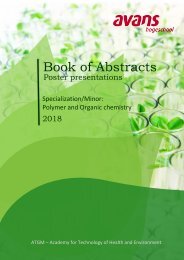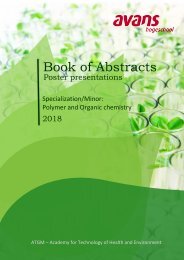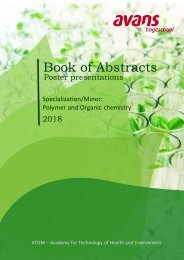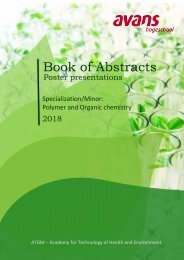Book of abstracts version 5
Create successful ePaper yourself
Turn your PDF publications into a flip-book with our unique Google optimized e-Paper software.
Isoxazoline ring opening by TBAT to form a β-lactam ring<br />
Author<br />
Linsey van Kempen<br />
Academy <strong>of</strong> Technology for Health and Environment<br />
Avans Hogeschool, Breda<br />
Paula Contreras Carballada<br />
g opening by TBAT to form a β-lactam ring<br />
Abstract<br />
Because β-lactam antibiotics are a widely used medicine, bacteria will be resistent through the excessive exposure.<br />
Therefore, new molecules with improved activity have to be found. In this research a β-lactam will be synthesized in three<br />
steps (Figure 1). The focus lies within the last step. In the research <strong>of</strong> P. Contreras Carballada there was TBAF used in this<br />
step. However, this didn’t work [1] In this experiment TBAT (Figure 2) will be examined to open the isoxazoline ring <strong>of</strong> 5<br />
and form the β-lactam ring. A big advantage <strong>of</strong> TBAT in comparison with TBAT is that it is anhydrous [2]. The first step is<br />
the condensation <strong>of</strong> N-benzylhydroxylamine 1 with ethylglyoxylate 2 in MTBE to form 3. Isoxazoline 5 will be formed by a<br />
[3+2] cycloaddition <strong>of</strong> 3 with trimethylsilylacetylen e 4 in THF [3]. In the last step, TBAT 6 will react with 5 in THF to form β-<br />
lactam 7. The intermediates and the product will be analysed with 1 H-NMR and FT-IR.<br />
Keywords: antibiotics, TBAT, β-lactam, condensation, [3+2] cycloaddition<br />
Table <strong>of</strong> content<br />
Figure 1: Overal reaction scheme.<br />
Figure 2: Tetrabutylammonium difluorotriphenylsilicate (TBAT).<br />
[1] P. Contreras Carballada, Untersuchung zur darstellung von 5 -trimethylsilyl-substituierten isoxazolinen und deren<br />
spaltung zu bèta-lactamen, 2003<br />
[2] P. DeShong and A. S. Pilcher, Utilization <strong>of</strong> tetrabutylammonium triphenyldifluorosilicate as a fluoride source for<br />
silicon-carbon bond cleavage, J. Org. Chem, 1996, 61, 6901 -6905<br />
[3] P. DeShong et al, J. Org. Chem. 1994, 59, 6282-6286<br />
59









